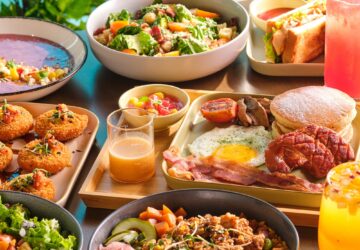On a weekly basis, many have meals planned out from Monday to Friday, maybe eat out on Saturdays and share lunch with family on Sundays. But in times of crisis, there is no guarantee that this will be the case and it probably won’t be even after the coronavirus catastrophe has passed. And that’s not even considering the plight of lower-income Filipino families and those living below the poverty line. The COVID-19 era has, without a doubt, exposed and stirred fears about food security.
Food security, according to the United Nations’ Committee on World Food Security, means there is sufficient and nutritious food easily available to all people at all times. So far, there are no major blows on food security despite COVID-19 prompting panic-buying and delays in supply distribution. This may not be the same however for underdeveloped nations that experience chronic hunger and severe food insecurity. If these countries suffer from inadequate food supplies in their normal state, what more can COVID-19 bring to the table? What impact does the coronavirus have on the global food scale, especially to the Philippines?
Lives at risk
Vulnerable countries, especially those already in crisis, and marginalized sectors such as service workers who rely on daily wages are at risk during this time. These service workers include public utility drivers, construction workers, food servers, retail workers, hotel and accommodation staff, delivery riders, contractual workers, and those who earn below minimum wage.
Without fresh goods, markets will be empty and higher prices will be imposed, making it harder to stay afloat with limited purchasing power or, worse, no income at all.
Farmers, included in the vulnerable livelihood sector, won’t be able to work on their lands to plant and harvest produce as well as access and deliver to markets due to mobility and road restrictions. Without fresh goods, markets will be empty and higher prices will be imposed, making it harder to stay afloat with limited purchasing power or, worse, no income at all.
Even children who rely on free school meals are also susceptible to the virus and even malnutrition. In the US, suspension of school means no student meal programs for around 22 million students who depend on lunch meals as their daily source of nutrition.
Negative effects
Metro Manila was put under community quarantine on Mar. 15 and shortly after, Luzon was placed in a state of enhanced community quarantine, restricting mobility and temporarily closing non-essential businesses.
In the law of supply and demand, the price of a product depends on availability and market clamor. For example, vegetables have been a staple for Metro Manila households. Since the quarantine started, delays in food deliveries have been reported due to checkpoints, resulting in price increases and potential food loss and waste and possible food shortages in the long run.
Last week showed a prime example: The Philippine Association of Meat Processors Inc., which includes Century Pacific, the brand behind Century Tuna and 555, appealed to Department of Trade and Industry (DTI) Secretary Ramon Lopez to allow raw meat materials to pass through designated checkpoints “after two member companies had shut down operations” and being lumped as non-essential food production.
Rural livelihood sectors involving live animals such as fishery, poultry and livestock are also affected because of labor shortage, logistical problems and reduced access to animal feeds on top of the fear of contagion from potential animal to human viral transmission.
Due to price hikes in commodities, people are more prone to panic-buying, breaking the supply chain that involves processes among producers, the transportation sector, processing plants, and shipping. This makes it difficult for specific industries to rapidly produce goods and services in order to respond to increasing demands. Rural livelihood sectors involving live animals such as fishery, poultry, and livestock are also affected because of labor shortage, logistical problems, and reduced access to animal feeds on top of the fear of contagion from potential animal to human viral transmission.
International trade relations may also suffer, particularly in those countries that rely heavily on food imports and exports. Most countries are implementing strict policies regarding shipping services and cargo vessels to prevent the risk of infection among crew members. The Philippines, known as the world’s biggest rice importer despite being a rice-centric country, only allots 10 percent of locally sourced rice supply during calamities while the remaining 90 percent are imported from countries such as China and Vietnam. Even though Vietnam suspended its rice exports, the Department of Agriculture assures that the country has enough rice inventory until June.
Recommendations and solutions
According to the Food and Agriculture Organization of United Nations (FAO), countries should be able to do these three things:
- Address the food needs of the marginalized and vulnerable sectors
- Implement social protection programs
- Adjust trade and tax policies for all
Our country’s poverty rate, though predicted to fall below 20 percent by 2021, is still relatively high. In order to address the population’s needs, the government should ensure that each family’s food requirements are met in order to prevent undernourishment. This may be in the form of cash or in-kind assistance together with government-led health and nutrition programs. The Department of Social Welfare and Development (DSWD) for instance has responded by sending around 2,000 food packs to the susceptible population in Masbate to aid them amid the quarantine.
School meal programs should also continue and officials should find alternative to deliver meals to students even outside school. US school officials for example found a solution by making arrangements for grab-and-go lunch bags and setting up delivery routes in order to effectively distribute lunch meals to students.
The Philippines, known as the world’s biggest rice importer despite being a rice-centric country, only allots 10 percent of locally-sourced rice supply during calamities while the remaining 90 percent are imported from countries such as China and Vietnam.
Another recommendation is boosting social protection programs that aim to prevent, manage, and overcome situations that can affect a person’s overall well-being. The government can provide support to small-scale producers and business owners, especially those in the agricultural sector, by developing online and mobile payment systems to allow quick transfers and deliveries amid the restricted mobility. This means food banks like Rise Against Hunger should be maximized with donations from individuals, non-government organizations, and companies to help the underprivileged.
In a bid to address this concern, DSWD had already released cash grants to around 140,000 beneficiaries of Pantawid Pamilyang Pilipino Program (4Ps), an initiative of the department to help the marginalized sector in light of the crisis. Some restaurants that deliver also enabled contactless delivery for extra safety measures while supporting their employees.
Last but not least, the government should be able to review trade and tax policies and adjust them accordingly. This should also involve monitoring prices and financial trends. In response, the DTI implemented a 60-day price freeze on all basic commodities across the country starting Mar. 11. This includes canned foods, instant noodles, bottled water, milk, coffee, candies, salt, laundry soaps, basic agricultural goods, essential medicines, firewood, charcoal, household LPG, and kerosene (LPG and kerosene will be frozen for 15 days only).
Overall, the government should ensure that all of its citizens are provided with their needs, whatever their social status is, with food on their plates and an assurance that help is readily available whenever possible.





